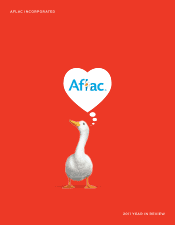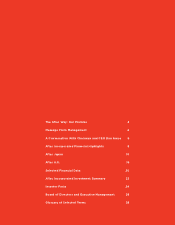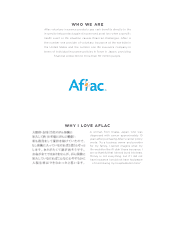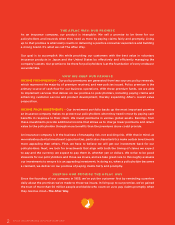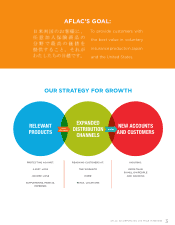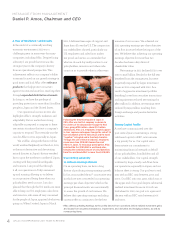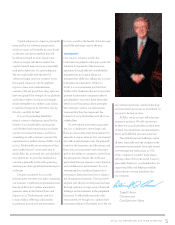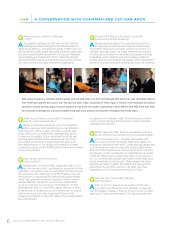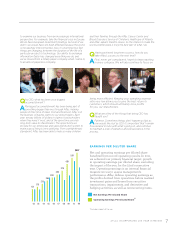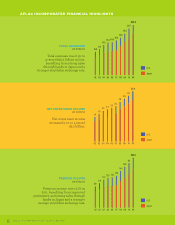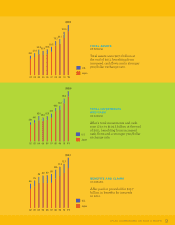Aflac 2011 Annual Report Download - page 6
Download and view the complete annual report
Please find page 6 of the 2011 Aflac annual report below. You can navigate through the pages in the report by either clicking on the pages listed below, or by using the keyword search tool below to find specific information within the annual report.
4 AFLAC INCORPORATED 2011 YEAR IN REVIEW
MESSAGE FROM MANAGEMENT
Daniel P. Amos, Chairman and CEO
A Year of Resilience—and Results
In the midst of a continually evolving
economic environment, 2011 was a
challenging year in many ways for many
companies, including Aflac. Despite facing
adversity, I am proud that 2011 was the
strongest year in the company’s history
from an operational perspective. This
achievement reflects our company’s ability
to remain focused on our growth strategy in
good times and bad: Aflac oers relevant
products that help protect consumers
against income and asset loss, reaching them
through expanded distribution channels.
In doing so, we have the privilege of
providing protection to more than 50 million
people in Japan and the United States.
Our operational success in 2011 also
highlights Aflac’s strength, resilience and
adaptability. But no matter how strong,
adaptable or prepared a company is, there
are certain situations that test a company’s
capacity to respond. That certainly was the
case for Aflac in 2011, especially in Japan.
We at Aflac, along with the rest of the
world, watched helplessly on March 11, 2011,
as the most destructive and devastating
natural disaster in Japan’s history wreaked
havoc upon the northeast coastline of Japan,
starting with the powerful earthquake
and tsunami. I am proud that through
it all, our operations in Tokyo remained
up and running, allowing us to deliver
on our promise of being there when our
policyholders need us most. I am also
pleased that through the U.S. media, we were
able to keep our U.S. employees, sales force
and investors, who were all very concerned
for the people of Japan, apprised of what was
going on. When I visited Japan in March
2011, I delivered messages of support and
hope from all over the U.S. The compassion
our stakeholders showed, particularly our
U.S. employees and sales force, makes
me proud and serves as a reminder that
what we do each day really matters to our
policyholders, investors and others who
count on us to provide value in other ways.
Overcoming Adversity
to Achieve Earnings Results
On an operating basis, we have a long
history of producing strong earnings growth.
In fact, 2011 marked the 22nd consecutive year
in which we met or exceeded our operating
earnings-per-share objective,* which is the
principal financial metric we use internally
to assess the growth of our business. We
believe that operating earnings, excluding
currency eects, continues to be the best
measure of our success. We achieved our
2011 operating earnings-per-share objective
of an 8.0% increase before the impact of the
yen. We believe that achieving our operating
earnings objective for more than two
decades has been a key driver of
shareholder value.
Net earnings in 2011 declined 16.2% over
2010 to $1.96 billion. Results for the full year
benefited from the stronger yen, but were
negatively impacted by larger investment
losses in 2011 compared with 2010. As a
result of aggressive investment portfolio
derisking, losses from securities transactions
and impairments reduced net earnings by
$850 million. In addition, net earnings were
reduced by $159 million, resulting from
foreign exchange and passive derivative
activities.
Strong Capital Profile
As we have communicated over the
past several years, maintaining a strong
risk-based capital, or RBC, ratio remains
a top priority for us. Our capital ratios
demonstrate our commitment to
maintaining financial strength on behalf
of our policyholders, bondholders and all
of our stakeholders. Our capital strength
is driven by huge, steady cash flows from
our operations, especially in Japan, and our
balance sheet is strong. Our goal was to end
2011 with an RBC ratio between 400% and
500%. Our RBC ratio was 493%, which was at
the upper end of our goal despite substantial
realized investment losses in 2011. As we
look ahead to 2012, our goal is to again end
the year with an RBC ratio between 400%
and 500%.
*Aac denes operating earnings as the prots derived from operations before realized investment gains
and losses from securities transactions, impairments, and derivative and hedging activities, as well as
nonrecurring items.
Following the Great Earthquake of Japan in
2011, Aflac was the first company to donate to
the victims of the devastation through the Red
Cross, giving ¥100 million—about $1.2 million.
Additionally, Aflac U.S. employees showed support
to their Japanese colleagues through the sale of $5
blue wristbands with the Aflac Duck and the word
“together” in English and in the Kanji character.
Through the sale of these wristbands, employees
raised more than $120,000 toward the relief
efforts in Japan. To encourage participation, Aflac
matched the first $100,000 in wristband sales,
bringing the combined amount of sales/donations
from this wristband effort to more than $220,000.

